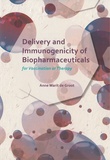Delivery and Immunogenicity of Biopharmaceuticals for Vaccination or Therapy
Summary
Biopharmaceuticals (or biologicals) are a new class of drugs produced by the biotechnology field and offer many advantages compared to classical small molecule synthetic drugs. Biopharmaceuticals (BP) are from biological origin and may consist of proteins or peptides, nucleic acids such as RNA and DNA structures or other parts of microorganisms and cells. The main difference between BP and small molecules is the complexity of the structure. BP offer more specificity on a variety of purposes. BPs show high specificity at receptor level or they can have a selective mode of action at gene level. Together this makes it possible to effectively intervene in disease pathways and makes it possible to either avoid or enhance immune activation. Biopharmaceuticals have expanded the range of options available for the treatment of complex diseases and DDS are designed to protect the BP structure and to facilitate barrier crossing. This thesis focuses on the challenges in delivery and imposed by immunogenicity of BPs and how this can be altered by the use of Drug Delivery Systems.
Part one of this thesis is focusing on delivery and immunogenicity of BPs for intradermal vaccination. In Chapter 2 a recently developed porous microneedle array is described and this chapter shows the successful induction of antibody responses towards two subunit vaccine antigens of the DTP vaccine. Inducing a Cytotoxic T cell response requires the presence of vaccine antigens in the cytosol of the cell and the use of a DDS could induce this membrane crossing. In Chapter 3 nanoparticles loaded with a model antigen and a TLR agonist adjuvant are delivered using hollow microneedles. Here, a cytotoxic T cell response was induced that was protective against an intracellular bacterium. Further, vaccine efficiency can be increased if the intracellular antigens become more immunogenic, i.e. would be more efficiently processed and presented to the adaptive immune system. Strategies to increase immunogenicity of vaccine antigens are described in Chapter 4 and include introducing activating helper proteins and proteasome-favorable cleavage sites in vaccine formulations.
Part two of this thesis focuses on delivery and immunogenicity of BPs for therapeutic use. While effects on the adaptive immune system are difficult to determine, the initial activation of the innate immune system can be assessed in vitro. In chapters 5-7, three different delivery system are developed. In Chapter 6 and 7, two new DDS show full immune compatibility. One DDS is for the delivery of siRNA and one for the delivery of a therapeutic hormone. While in chapter 6 the DDS consisted of peptide-polymer hybrid nanoparticles, in Chapter 5 a lipid-polymer hybrid combination was used for the delivery of siRNA. Combining the lipidoid structures with a polymer-based nanoparticle prevented the lipidoid-mediated activation of the innate immune system.
The results of this thesis are summarized and discussed in Chapter 8.
